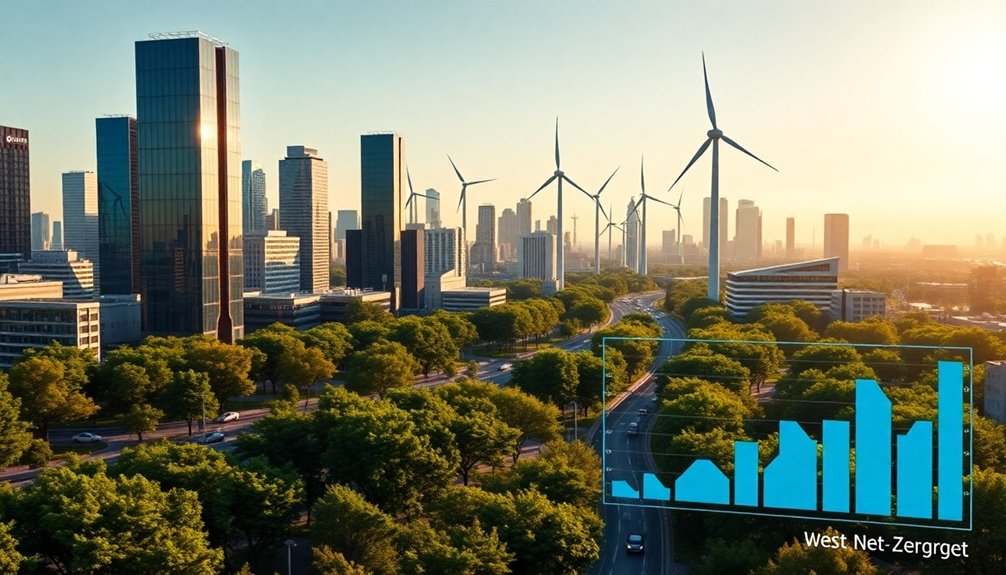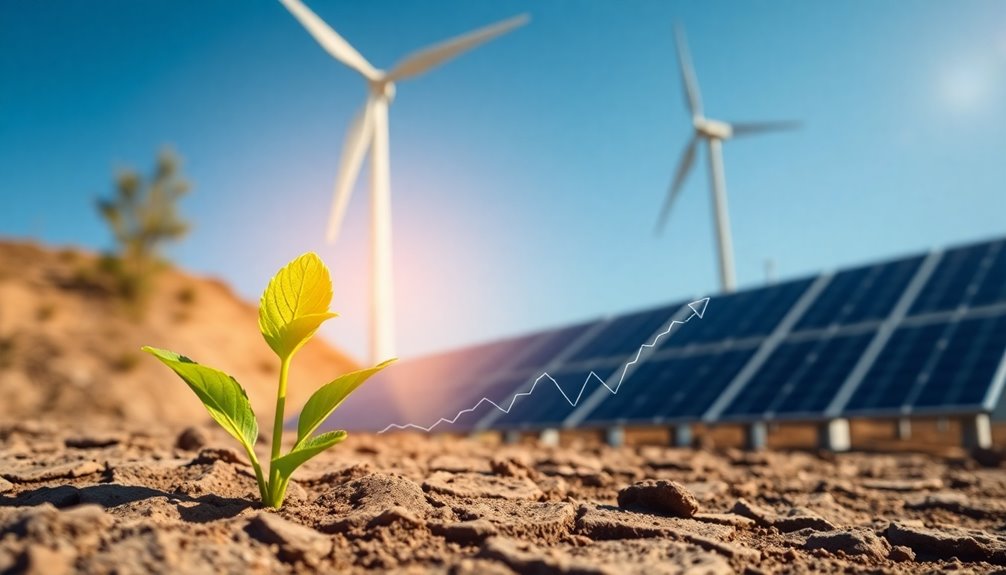Low-carbon fuels play a vital role in achieving net-zero targets, projected to meet 20% of global energy needs by 2050. You can't overlook their importance in energy systems and integrated assessment models. Policies around the world are pushing for biofuels and synthetic alternatives, particularly in hard-to-abate sectors. While challenges exist in production and infrastructure, ongoing innovation is key. There's much more to uncover about how these fuels transform our energy landscape for a sustainable future.
Key Takeaways
- Low-carbon fuels are vital in integrated assessment models for achieving net-zero targets by 2050, especially in hard-to-abate sectors like heavy industry and transport.
- Policy frameworks across 80 nations promote biofuels and hydrogen strategies, driving innovation and investment in low-carbon technologies.
- Tailored fuel solutions are necessary, as different sectors require specific fuel types to effectively transition to net-zero emissions.
- Technological challenges and high production costs hinder the widespread adoption of low-carbon fuels, necessitating infrastructure development and investment.
- Continuous research and collaborative efforts are essential to overcome existing barriers in low-carbon fuel production and enhance policy effectiveness.

As the world grapples with climate change, low-carbon fuels are emerging as a vital solution for achieving net-zero targets by 2050. These fuels, including biofuels and synthetic options, are essential for replacing fossil fuels, especially in hard-to-abate sectors like heavy industry and long-distance transport. You'll find that transitioning to low-carbon fuels isn't just a trend; it's a necessity for reaching those ambitious net-zero goals.
To hit net-zero emissions by 2050, we need a significant uptick in low-carbon fuel production and use. This is particularly crucial in industries where electrification poses challenges. Countries around the globe are taking action, with around 80 nations implementing policies to support biofuels and 31 focused on hydrogen strategies. These policy frameworks are vital, as they encourage innovation and investment in low-carbon technologies. Low-emissions fuels play a crucial role in reducing carbon emissions across various sectors and provide a potential alternative to fossil fuels in existing infrastructure.
Achieving net-zero emissions by 2050 requires a surge in low-carbon fuel production and supportive policies across nations.
However, the journey isn't without its hurdles. Producing low-carbon fuels like synthetic fuels comes with technological challenges, including high costs and a limited supply of sustainable feedstocks.
You may also notice that the infrastructure for these fuels requires substantial development, particularly in aviation and maritime sectors. Expanding this infrastructure is essential for enabling the wide-scale adoption of low-carbon solutions.
Integrated assessment models emphasize the necessity of low-carbon fuels in energy systems, particularly where electrification isn't feasible. Different sectors have unique requirements—for instance, aviation demands high-energy-density fuels like synthetic kerosene. This diversity in fuel types is crucial for a successful transition.
Frequently Asked Questions
What Are the Main Types of Low Carbon Fuels?
When you're exploring low-carbon fuels, you'll find several main types.
Ethanol and biodiesel come from organic materials and are net-carbon neutral. Renewable diesel, or HVO, serves as a fossil diesel replacement.
Hydrogen, often produced by electrolysis, is carbon-free when sourced sustainably.
Biomethane and synthetic methane, derived from biogas and renewable processes, respectively, offer carbon-neutral alternatives.
Lastly, ammonia and e-fuels provide promising options for energy storage and shipping applications.
How Do Low Carbon Fuels Compare to Traditional Fossil Fuels?
When you pit low-carbon fuels against traditional fossil fuels, it's like comparing a racehorse to a tortoise!
Low-carbon fuels emit significantly fewer greenhouse gases, making them the eco-warriors of the energy world.
While fossil fuels might be cheaper, low-carbon options like hydrogen and biofuels are paving the way for a cleaner future.
They may need engine tweaks and face scalability hurdles, but the environmental benefits are undeniably worth it!
What Role Do Renewable Energy Sources Play in Net-Zero Targets?
Renewable energy sources play a crucial role in achieving net-zero targets. By harnessing solar, wind, and hydroelectric power, you can significantly reduce carbon emissions and replace fossil fuels.
As these technologies advance, they'll provide cleaner energy solutions while fostering economic growth. However, integrating renewables into existing systems requires modern infrastructure and storage solutions to address intermittency challenges.
Embracing this transition is essential for a sustainable and resilient energy future.
Are There Economic Challenges Associated With Low Carbon Fuel Adoption?
Yes, you'll find economic challenges tied to adopting low-carbon fuels. Costs are higher, and you might notice that production efficiency lags behind fossil fuels.
Supply chains can be limited, making it tough to scale up. Plus, you'll often rely on government support to make these fuels competitive.
Regulatory frameworks are inconsistent, adding another layer of complexity. Without significant investment and technological advancements, the transition can feel daunting and slow.
How Do Government Policies Influence Low Carbon Fuel Development?
Government policies significantly influence low carbon fuel development by setting clear standards and targets, like the Low Carbon Fuel Standards (LCFS) and Renewable Transport Fuel Obligation (RTFO).
These regulations drive innovation and investments in cleaner fuel technologies, creating jobs and boosting the economy.
Incentives such as credits and subsidies encourage production and consumption, while promoting competition enhances consumer choice.
Ultimately, these policies help you transition to more sustainable energy options.
Conclusion
In the race to net-zero, low carbon fuels emerge as both saviors and challengers. While they offer a promising path to reduce emissions, their integration into energy systems often reveals conflicting narratives of feasibility and technology readiness. You see, it's not just about adopting cleaner alternatives; it's about balancing innovation with practicality. As you navigate this complex landscape, remember: the right mix of low carbon fuels could either propel us forward or stall our progress toward a sustainable future.









